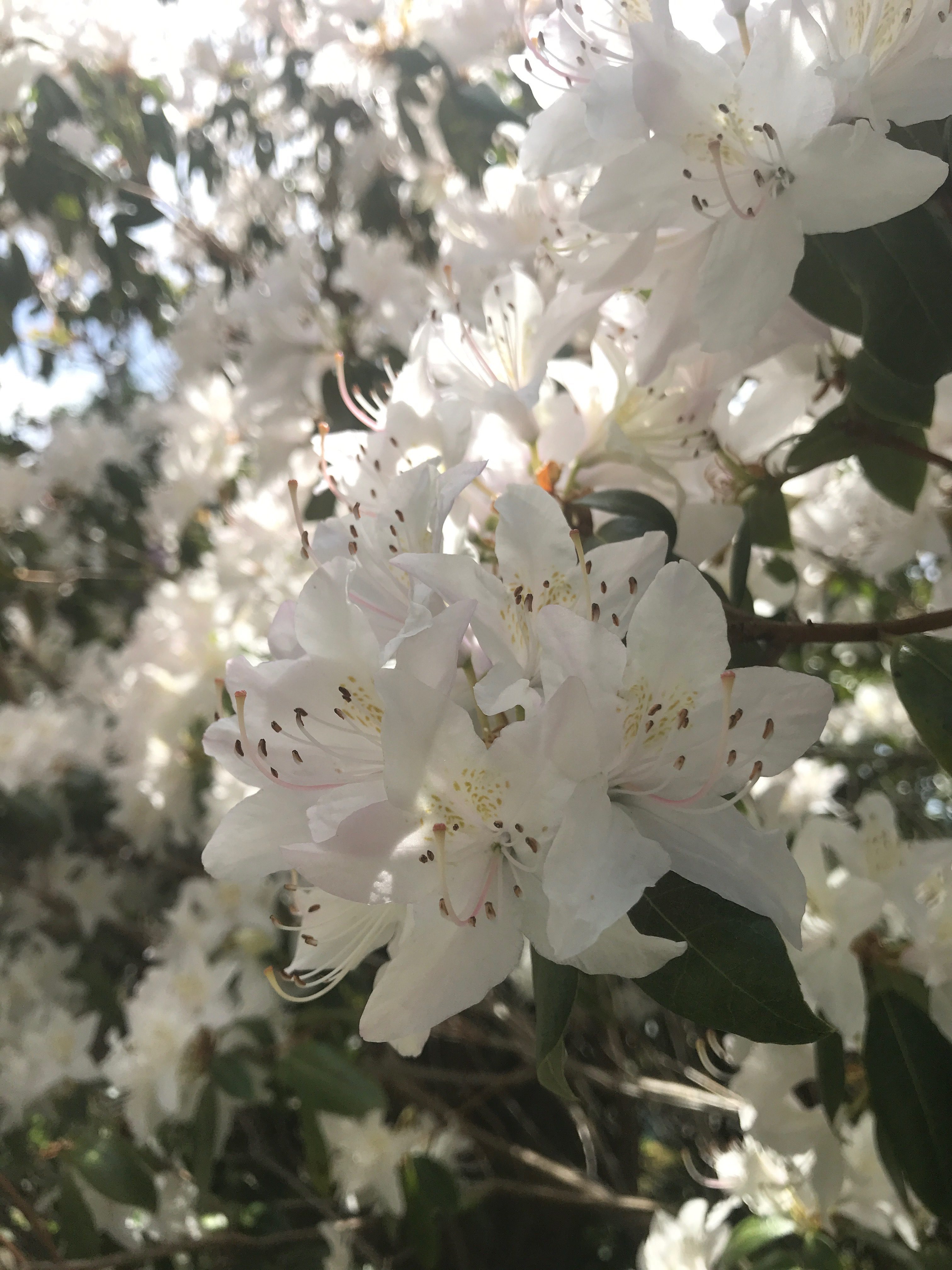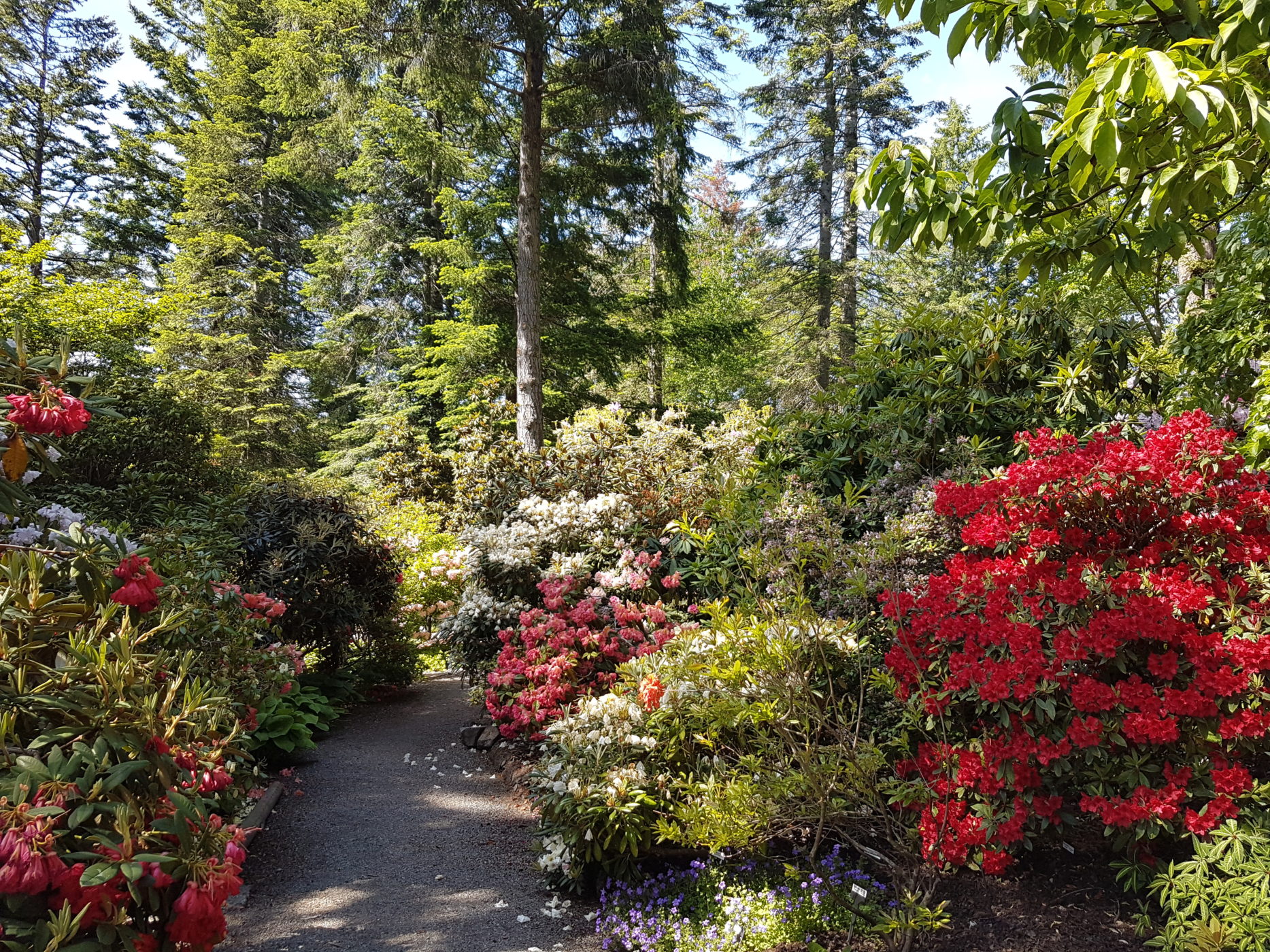Student Blog Posts - Rhododendrons
This is a blog post in two parts - please enjoy all the great rhododendron information from our students at Pacific Horticulture College!
Part 1: Rhododendrons
by: Riley Kenler
 Having grown up on a grain farm in Southeast Saskatchewan, I was fortunate enough to have more land to play with then one physically could. Being that my parents were very actively involved in the outdoors, I as well was forced to spend my time out there too. When I was 7 my parents built a house on a piece of my dad's land, the yard site was subdivided from the quarter and my mom now had 13 very flat acres of “gardens/lawns” to explore. Summer after summer my brother and I weeded row after row, hundreds after hundreds of trees my mom planted that served as a shelter belt for our farm. Amongst the inside of these trees lied multiple flower beds full of perennials, annuals, shrubs, fruiting trees etc. If it would grow, she planted it!! Being exposed to these variety of plants and green house trip after greenhouse trip I began my interest in plants. In 2010 I purchased my own acreage with the intentions of pursuing my own planting schemes on my own “clean slate of a yard”. For 7 years I visited multiple greenhouses and tested zones to see what would grow in my yard and what wouldn't, some very successful trials.... some not so much. In the spring of 2018, I moved to the island. Having never travelled to B.C., I thought I had a quite a decent understanding of plant knowledge and the mast variety of plants that could be grown in Canada, not really understanding that the island was a climate in its own. Upon my arrival to Victoria, many spring flowering plants were just reaching their glory. That was when I curiously stumbled upon Rhododendrons. I had not in my 26 years of countless trips to the green house, and world travel come across a plant as magnificent as this.
Having grown up on a grain farm in Southeast Saskatchewan, I was fortunate enough to have more land to play with then one physically could. Being that my parents were very actively involved in the outdoors, I as well was forced to spend my time out there too. When I was 7 my parents built a house on a piece of my dad's land, the yard site was subdivided from the quarter and my mom now had 13 very flat acres of “gardens/lawns” to explore. Summer after summer my brother and I weeded row after row, hundreds after hundreds of trees my mom planted that served as a shelter belt for our farm. Amongst the inside of these trees lied multiple flower beds full of perennials, annuals, shrubs, fruiting trees etc. If it would grow, she planted it!! Being exposed to these variety of plants and green house trip after greenhouse trip I began my interest in plants. In 2010 I purchased my own acreage with the intentions of pursuing my own planting schemes on my own “clean slate of a yard”. For 7 years I visited multiple greenhouses and tested zones to see what would grow in my yard and what wouldn't, some very successful trials.... some not so much. In the spring of 2018, I moved to the island. Having never travelled to B.C., I thought I had a quite a decent understanding of plant knowledge and the mast variety of plants that could be grown in Canada, not really understanding that the island was a climate in its own. Upon my arrival to Victoria, many spring flowering plants were just reaching their glory. That was when I curiously stumbled upon Rhododendrons. I had not in my 26 years of countless trips to the green house, and world travel come across a plant as magnificent as this.
Rhododendrons come from the family Ericaceae; the genus Rhododendron comprises over 800 species varying from small rock-garden plants to 12m high trees. According to Bill McMillan “a well-grown plant is sturdy, well balanced, suffers minimal damage from wind and snow, blooms profusely, and makes optimum use of available moisture. A well-balanced plant has an above ground structure that is adequately anchored and serviced by its root system.”
Rhododendrons have many uniquely shaped fragrant flowers consisting of tubular to bell-shaped through to widely funnel shaped. Variations range from an open funnel to openly bell-shaped, even to flat saucer shaped or rotate. The size of flowers can range from millimeters to more than 5 centimeters. They come in a variety of colours that range from white through pink to red, yellow to orangey or greenish yellow, and mauves to purple.
The soil requirements of rhododendrons can be dependent on the moisture levels that will be present to them. As an example, they will tolerate sandy loams, provided they are kept moist and clayey loams provided they are well-drained. They grow best in organic-rich, well-drained loam (loam being a mixture of sand, clay and humus with enough sand to prevent clumping of clay).
When planting, it is crucial that the root balls are thoroughly saturated before they are placed in the ground and then again after planting. Planting/transplanting can take place in the fall, winter or early spring, but late fall or early winter is best. Always plant high, as through time compaction will occur. Roots are shallow and want wide root balls 8-12" deep extending almost to the dripline. Tease out roots from pots (often pot bound when bought), make slits in the root ball from top to bottom at 1.5cm intervals. Rhododendrons are easily moved. Begin by digging a trench about one spade deep around the drip line. Push your spade under the root all around the plant. Then pry upward and the flat root ball will pop out of the ground. Never heavily mulch the top of the root ball after planting/and or in general.
There are three types of pruning; 1. leaf bud pruning--- promotes bushy growth, 2. deadheading--- after flowering for appearance and good flowering next year and 3. woody pruning--- for size and shape control.
When selecting the perfect location for your rhododendron size & light requirements play an effective role. As Bill stated “choose a variety that will grow in scale appropriate to your landscape needs.” Typically, the larger the leaf, the more shade required. Dwarf alpine varieties are effective in rock gardens, whereas compact “ground-hugging” varieties are ideal for containers on shaded patios and larger rhododendrons are excellent for woodland gardens.
Lastly if there wasn't a saying I heard more at the HCP it is “Right Plant, Right Place!!!”
Part 2: Rhododendrons - A Long Way From Home
by: Stuart Maclean
 Bill McMillan is the lead steward of the Rhododendron garden at HCP and has a passion for the plant that is evident in the way he talks about them if you care to listen. Having spent the last 19 year as a volunteer, he not only has a wealth of knowledge about rhododendrons, but the enthusiasm he shows has sparked an interest in myself to want to learn more about this fabulous plant.
Bill McMillan is the lead steward of the Rhododendron garden at HCP and has a passion for the plant that is evident in the way he talks about them if you care to listen. Having spent the last 19 year as a volunteer, he not only has a wealth of knowledge about rhododendrons, but the enthusiasm he shows has sparked an interest in myself to want to learn more about this fabulous plant.
As a part of the Family Ericaceae, there are over 800 stable species in the Genus Rhododendron. From these species, there is an astounding amount of hybrids that have been found - or purposefully created - that number around 35000. Despite the high amount of straight species and hybrids, there are only two rhododendrons that are native to British Columbia (Rhododendron albiflorum and Rhododendron macrophyllum). Rhododendrons have been found to be native to Asia and usually at elevations exceeding 2000 meters above sea level. In parts of the Himalayan mountains, rhododendrons have been found to stand 30 meters tall. The deep valleys and high hills there naturally began the speciation of rhododendrons.
Within the Rhododendron genus, are four main sub-genus'. These four sub-genus' are the Hymenanthes (Elepidotes), Pentanthera (Deciduous azaleas), Rhododendron (Lepidotes), and Tsutsutsi (Evergreen azaleas). The elepidotes are easily distinguished by having large leaves that do not have scales on the back of them paired with larger flowers. These flowers can be scented, but are not always so. At HCP, some of the species we have include R. fortunei, R. discolor, R. decorum, and the hybrids ‘Loderi King George', Loderi Venus' and ‘Naomi Pink Beauty'. Lepidotes, in contrast, have small leaves that have scales on the back and bear numerous small flowers. This sub-genus host some of the most fragrant of rhododendrons. Unfortunately lepidotes are not reliably hardy outdoors so they are difficult to grow here in Victoria. However some varieties of edgeworthii are marginally hardy here. Deciduous azaleas often have flowers that appear before the leaves. Their flowers are always 5-lobed and are commonly, but not always, fragrant. There is a good collection in the gardens here at HCP, including the species R. luteum and R. occidentale. We also have many hybrids including ‘Gibraltar', Snowbird', ‘Bountiful', and ‘Irene Koster'. The last group - the evergreen azaleas - have leathery leaves that have adpressed hairs on the tops of them that are soft to the touch. Their leaves and flowers appear together in the same bud and it is not known if their flowers ever have any fragrance.
When planting rhododendrons, you ideally want to plant them in a spot that gives them a 50/50 mix of sun and shade. For all species and hybrids, it is best to mound the area they are being planted in. This is to make sure their roots have the best drainage possible. Over time this mound will settle back down and become flush with the normal ground level so this is not a permanent mounding. It is imperative that they are placed in the correct location, otherwise they can become more susceptible to pests and diseases.
With the sheer amount of variety encompassing the genus Rhododendron, and even here in Victoria being so far away from their native home, there are endless options to choose from when planning to plant rhododendrons in your home garden. The hardest part might just be finding the variety you want to plant.


